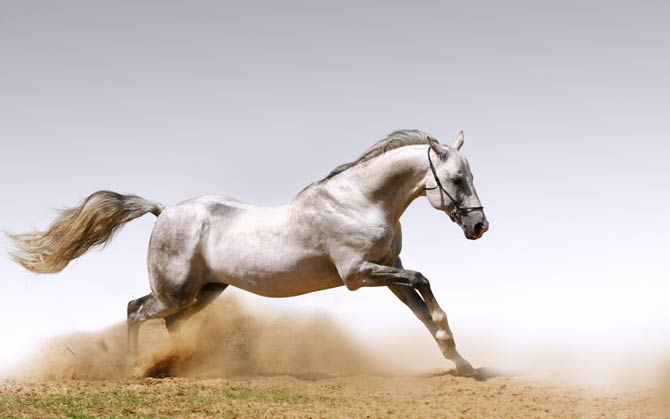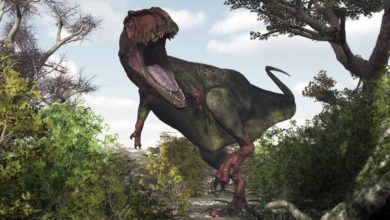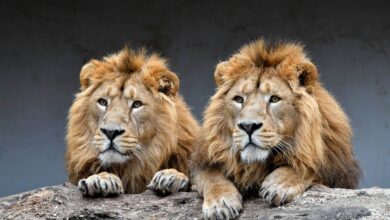Horse (Equus ferus caballus)
Since ancient times, man has appreciated the strength, speed and intelligence of horses – the oldest domestic breed was bred as early as 5,000 years ago. There is no exaggeration in saying that these beautiful quadrupeds changed our lives and… the course of history.
From primeval wild horse to domestic horse
When and where wild horses were domesticated for the first time is more or less controversial and can hardly be narrowed down. It is very likely that the domestication of the original wild horse into a domestic horse did not only take place in one region. Wild horses once lived across large areas of Eurasia and it is very likely that people in the Neolithic (Neolithic) period in different places, but independently of one another, attempted to domesticate horses. The time frame extends from 3,000 to 5,000 years before our era.

Evolution of the horse
The evolutionary history of the horse can be documented quite well with paleontological finds of fossils and skeletal remains compared to the tribal history of other animal species. There are only unanswered questions regarding the classification of the finds in the family tree and with regard to the spread of the equidae.
One of these questions that have not yet been fully answered concerns a small animal with a shoulder height of no more than 40 cm (according to other information, no more than 20 cm) and the scientific name Hyracotherium. This little herbivore probably roamed primeval forests in small groups in front of about 55 to 45 million in North America and Eurasia.

Horse – human helper
Thanks to horses, people began to cover longer distances in a shorter time, which brought about the development of communication and trade. They also revolutionized farming and industry. The cavalry more than once determined the results of battles.
Currently, these animals are rarely harnessed for hard, physical work, and more and more often they are bred for sports purposes. Horse breeding is also a favorite hobby of millionaires.
The direct ancestors of modern domestic horses were wild horses, which can now only be found in the open territories of Asia and Africa. The oldest living species is Przewalski’s horse, but the most distinguished breed is undoubtedly the Arabian horse. It was the crossbreeding of Arabians with European horses that gave rise to domestic varieties.
Specific needs and climatic conditions shaped a number of characteristics in individual breeds. Breeds with long, slim legs are the fastest, while those with massive conformation work well. Long-haired horses feel good even in cold climates.
The anatomy of all horses is basically the same, but they may differ in proportions of particular parts of the body and the color of the coat. Horses are grouped into the following breeds: hot-blood, cold-blood, warm-blood, primitive and ponies.

Different types of horses
Horse breeds differ in terms of body type, height, fur and color. Depending on the purpose for which horses are bred, the animals are divided into the following types:
Thoroughbreds:
This type comes from Arabian breeding and is used as a sport horse. These breeds reach speeds of up to 70 km / h. A distinction is made between Arabian and English whole blood.
Cold-blooded horses:
Horse breeds with a much stronger build, come from colder regions and are suitable for pulling loads, such as heavy carriages.
Warm-blooded animals:
Cross between cold-blooded and whole-blooded animals with the aim of extracting the best benefits from both types. Warm-blooded animals are suitable for horse sports.
Half-breeds:
Cross-breed of thoroughbreds with another horse breed, so one parent must be a thoroughbred Arab.
Ponies:
Small horses with a withers height of less than 148 cm. They are used for riding and driving carriages.
The typing in cold, warm and whole blood is not dependent on the amount or temperature of the blood. This is how the temperament of the horses is classified. Cold-blooded animals are generally rather calm and not so frightened, while whole-blooded animals are considered nervous and easily excitable.

Horse age in relation to human age
Horse Man [years]
1 3
2 6
3 9
4 12
5 15
6 18
7 21
8 24
9 27
10 30
11 33
12 36
13 39
14 42
15 45
16 48
17 51
18 54
19 57
20 60

What does a horse eat?
Horses are pure herbivores that mainly feed on grasses and herbs. Like all herbivores, horses are permanent eaters. Leaves, flowers, roots, shrubs, fruit, berries and seeds also belong to the diet. A horse eats between three and five kilograms of feed per hour. A four-legged friend weighing around 500 kg eats between 10 and 15 kg of hay a day.
How many horses live worldwide?
There are approximately 60 million horses worldwide.

How do horses live?
The horse is a typical herd animal and therefore has a very distinctive body language for communication between the animals. Groups consist of several mares and their foals as well as a stallion. In larger groups there can also be several stallions. The stallion is responsible for the protection of his herd.
The movable auricles are a very important means of communication for horses. If these are directed alternately forward and backward while standing, the horse shows attention and curiosity – also towards people. If the horse has both ears pointing backwards, this is a warning, the horse usually signals an imminent defensive reaction.
How do people use horses?
Horses are very popular pets and farm animals. The different types can be used in different ways. Thoroughbreds and warmbloods are suitable as mounts, but also as draft horses for light carriages. Cold-blooded horses are used almost exclusively as draught and work animals due to their mass and slower gait. A well-known example is the plough horse.

Horses – interesting facts
- There are over 200 horse breeds in the world.
- Horses live to an average of 30 years. Only 2% of the population is over 30 years old. It is believed that the oldest horse was an Irish Draught horse, who died at the age of 51. That’s the equivalent of about 120 years for human age.
- Racing horses run at up to 88 km/h (55 mph) – Quarter Horse.
- Although Arabians are very strong, they are sensitive to… bad weather.
- The first known ancestor of a horse 50 million years ago was only 30 cm (12 in) tall. It looked like… a fox.
- The oldest breed of domestic horse was bred over 5.5 thousand years ago.
- The color of the mane and tail are usually different from the color of the coat.
- Horses can take a nap in a standing position.
- Stallions usually have better eyesight than mares. They must be constantly alert, protecting the herd from predators or rivals.

Recommended
- Zebroid
- Elephants
- Giraffe
- Grizzly bear
- Largest eagles Top10
- Largest birds of prey Top10
- Animals & dinosaurs records
- The fastest animals – Top 100
- The fastest birds – Top 10



















You made a good point when you mentioned that horse is a great creature that can be used in different ways either as pets or farm animals. It is very important to keep them in our ecosystem and prevent them from being extinct.